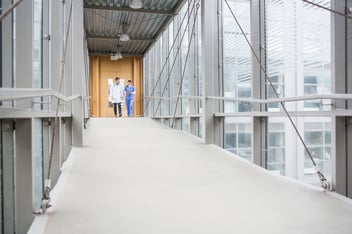Nearly everyone these days is walking around with a hyperconnected supercomputer on their person—a hyperconnected supercomputer that is able to determine its own location on this great green earth. This is a powerful capability, driving key applications that help people navigate unfamiliar areas, find friends, and, of course, order junk food late at night.
GPS deservedly gets much of the credit here. It’s one of those modern marvels that’s too easily taken for granted. The constellation of 30 or so satellites moving through orbit gives all kinds of devices the information they need to locate themselves. One drawback to this space-tech, however, is that it’s in space. Without a clear line of sight to the sky, GPS accuracy tanks quickly.
This makes location awareness inside large, complex facilities a tough nut to crack—or at least a nut requiring a different cracking technique. But before we dive too deep into the nerdy details, we’d best reflect on the why, and whether this endeavor is worthy of our collective time.
The Why
As with GPS, a successful IPS (Indoor Positioning System) implementation gives additional context to users of an application. It also gives context about users of an application and, of course, context to the application itself. It creates a mapping between the physical and the digital, creating some unique opportunities for interaction between the two. These are all great capabilities to have, and can unlock some interesting potentials. Potentials such as these:
- Navigation: Knowing where a user is and where they want to go, applications can guide them from one location to another. This is a powerful way to empower users to make the best use of everything a facility has to offer.
- Custom Content: Location awareness gives savvy solutions the opportunity to personalize the experience. A top priority here is discoverability—direct attention to relevant areas of greatest interest.
- Targeted Communication: When and where are two great things to know when deciding what information to push to users. Segmenting communication to keep real-time updates relevant is important to keep it separate from the noise.
- Automated Experiences: Taken one step further, that physical to digital link can trigger key flows, streamlining bothersome experiences like check-ins. Or check-outs. The more of this that can be done behind the scenes, the better.
- Asset Tracking: The ability to track inventory and equipment is huge, making it easy to find things when needed. An alert system here can save staff time, and be a help if theft is a common occurrence.
- Accessibility: Many tools exist to help people of different needs. Location aware applications can help users discover them and better leverage assistive tools of their own. Something as simple as mapping out wheelchair accessibility goes a long way towards empowering users and lends confidence in navigating your facility.
- Security: When there is trouble, knowing where it’s happening and determining the closest personnel is key to a rapid response.
- Intelligence: Knowing how users navigate and congregate within a location can give some compelling and actionable analytics, improving staff efficiency and facility optimization.
- Mixed Reality Experiences: In a future where Augmented Reality technology becomes widely adopted, location awareness will be absolutely critical to anchoring that experience. Most current applications rely on visual tagging, which is just ok.
Indoor location awareness is still pretty fresh, with a few solutions able to function with great reliability and efficiency at scale. It’s one of those foundational systems where it can be truly exciting to see what sort of creative solutions will be built on the core of a robust new technology. Or, if not new, a technology that’s finally finding its footing.
Tune in next time for a deeper dive into common techniques used to determine indoor position and some of the technology which powers it.


